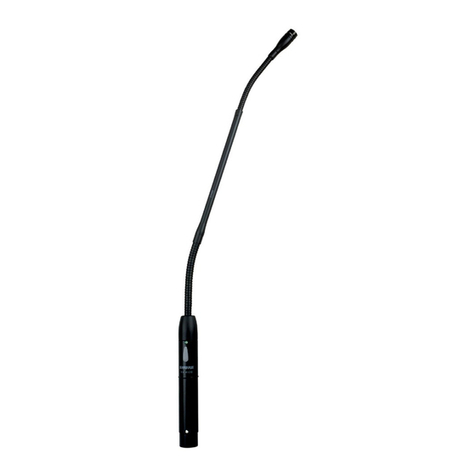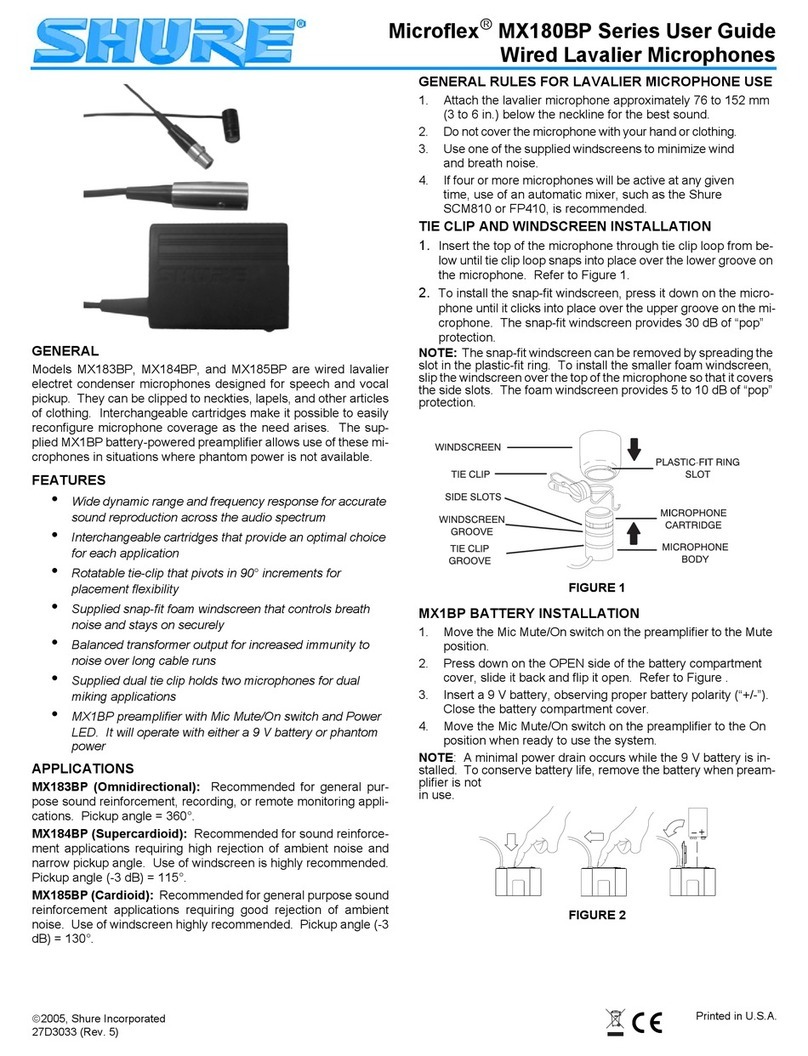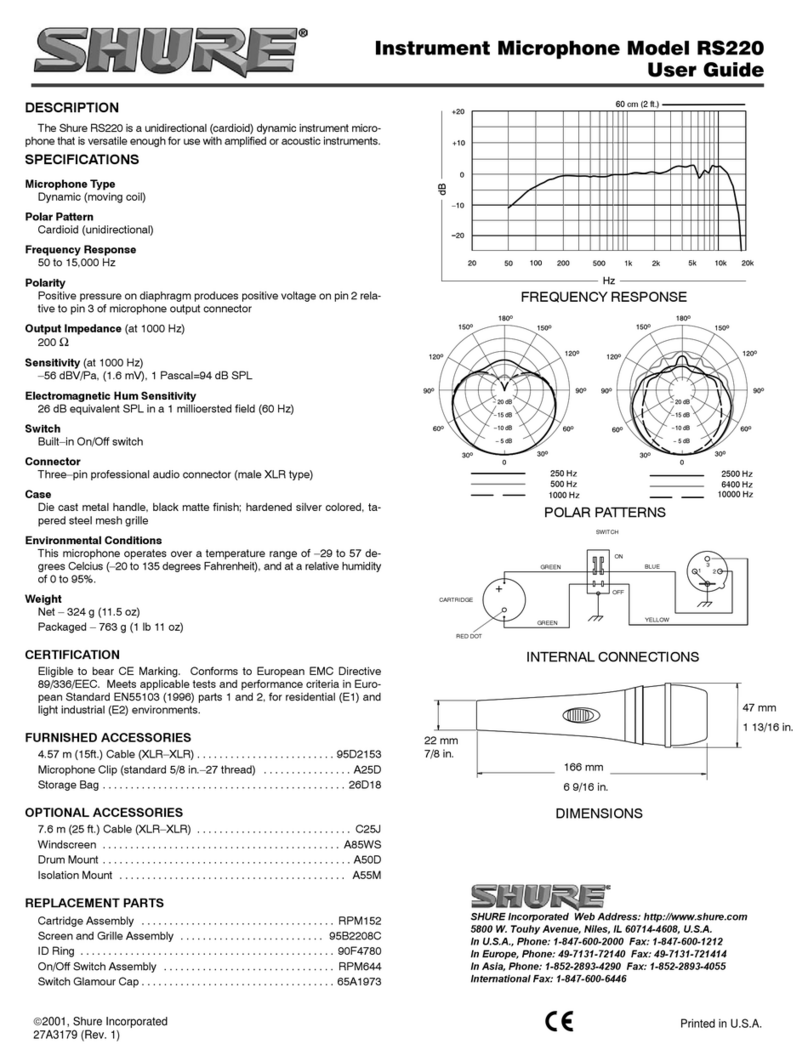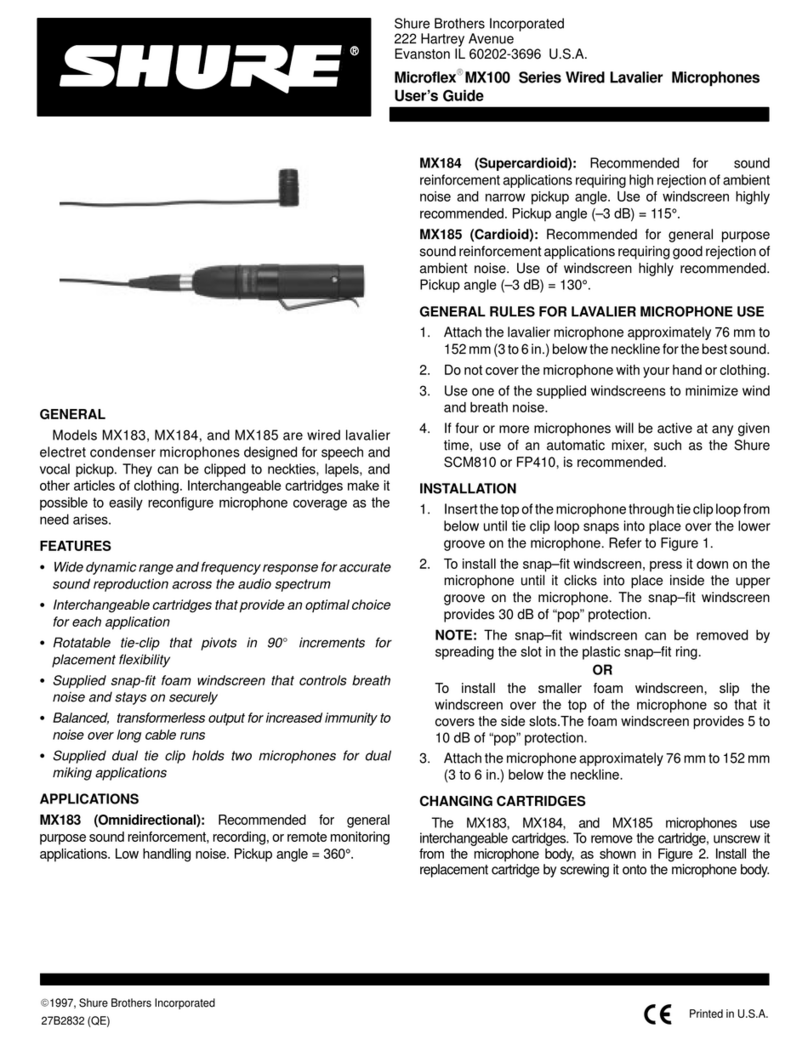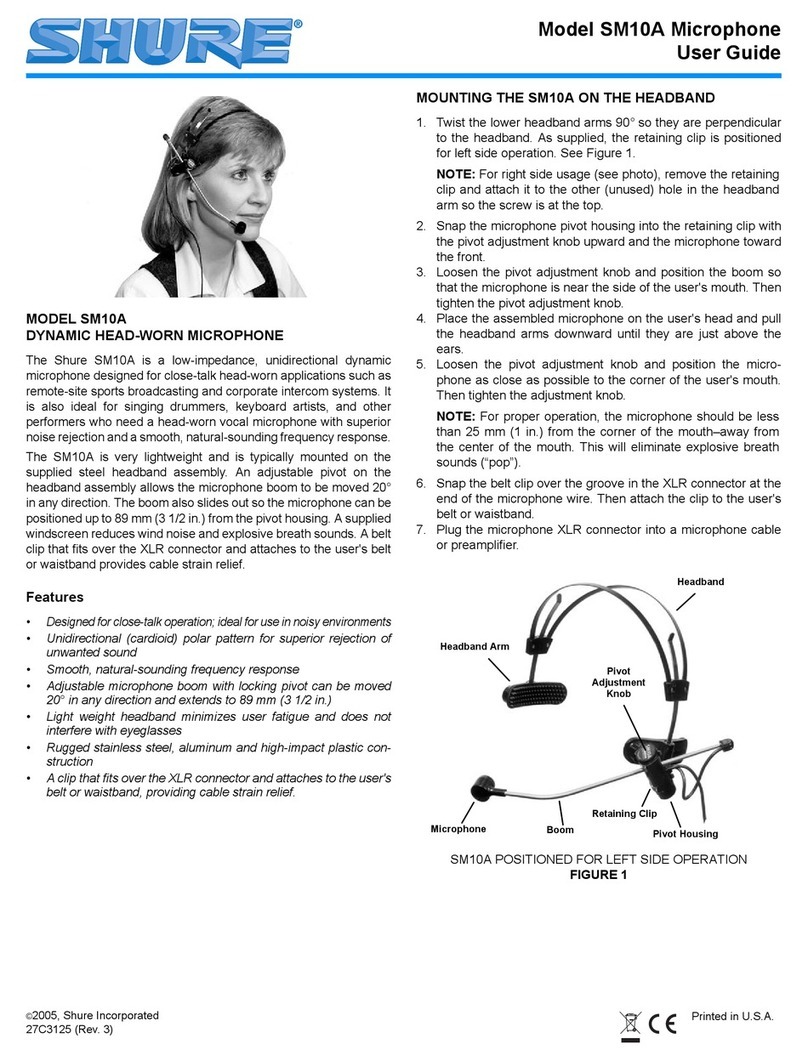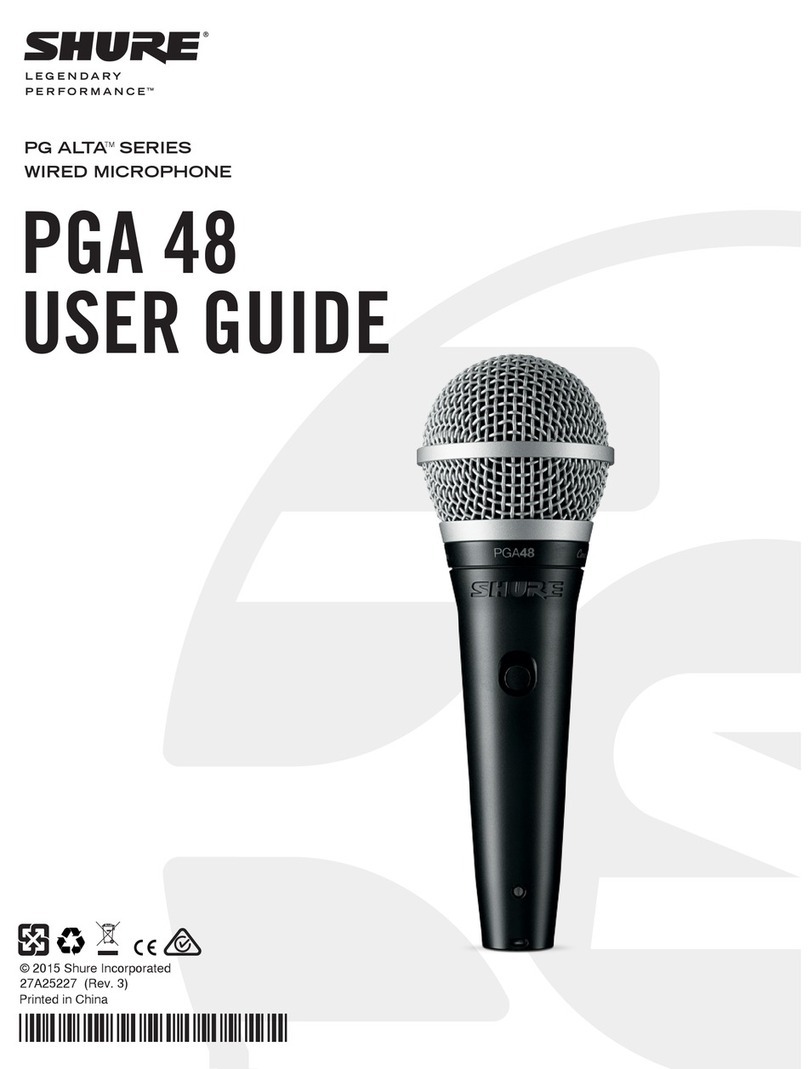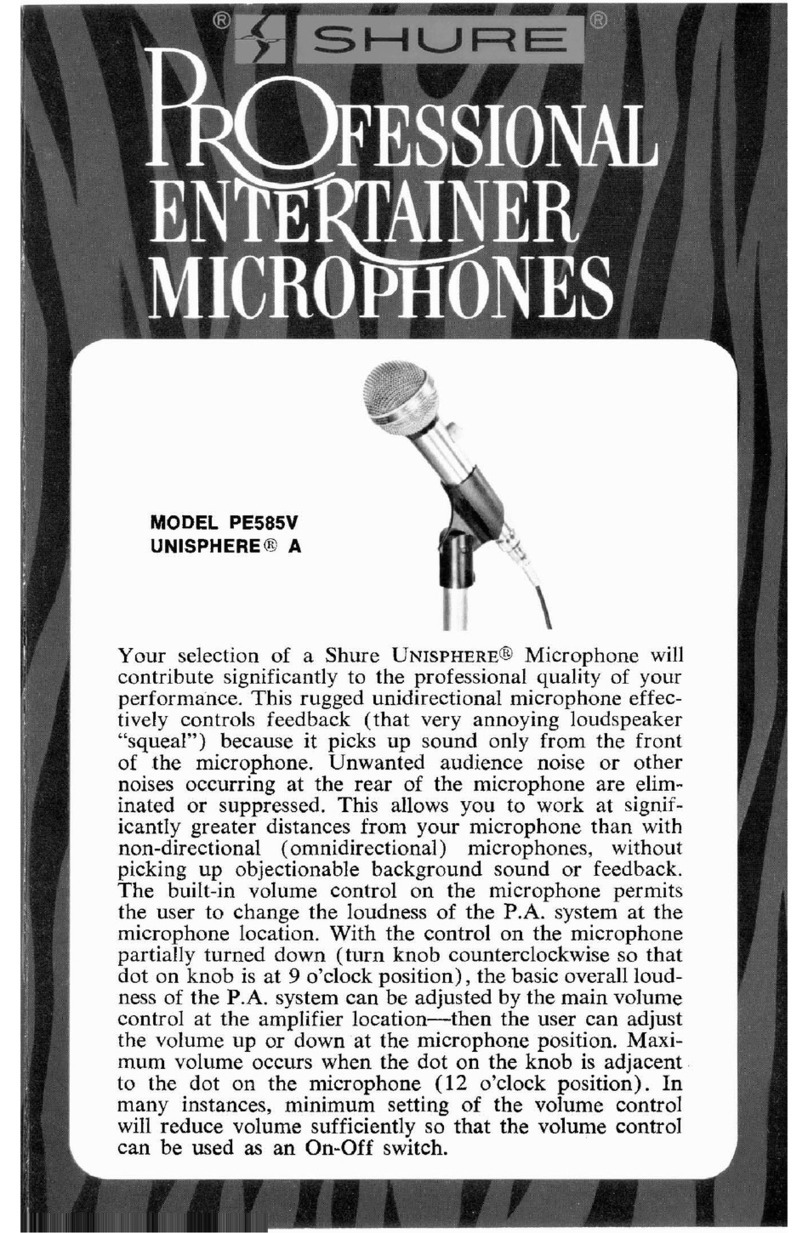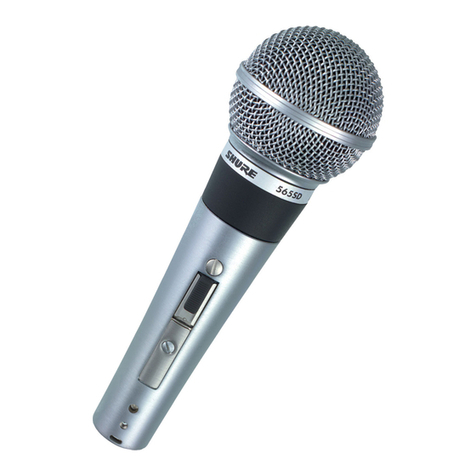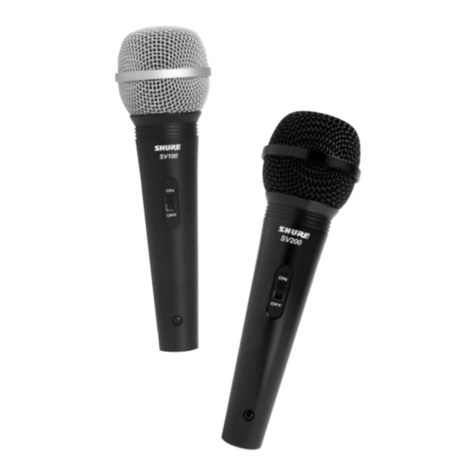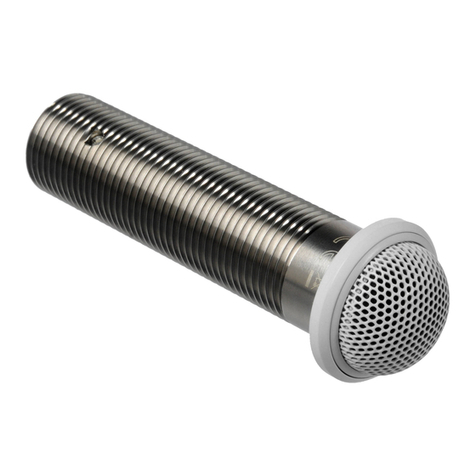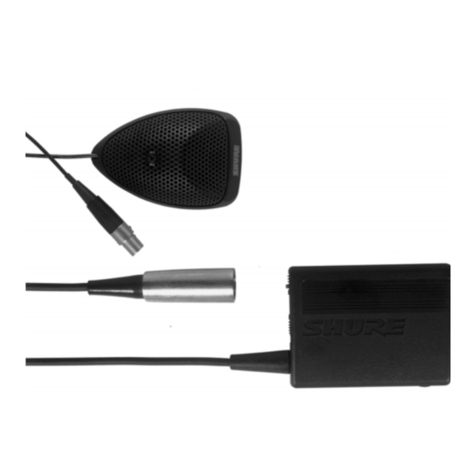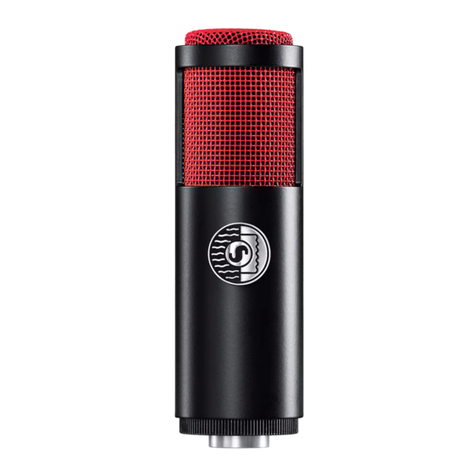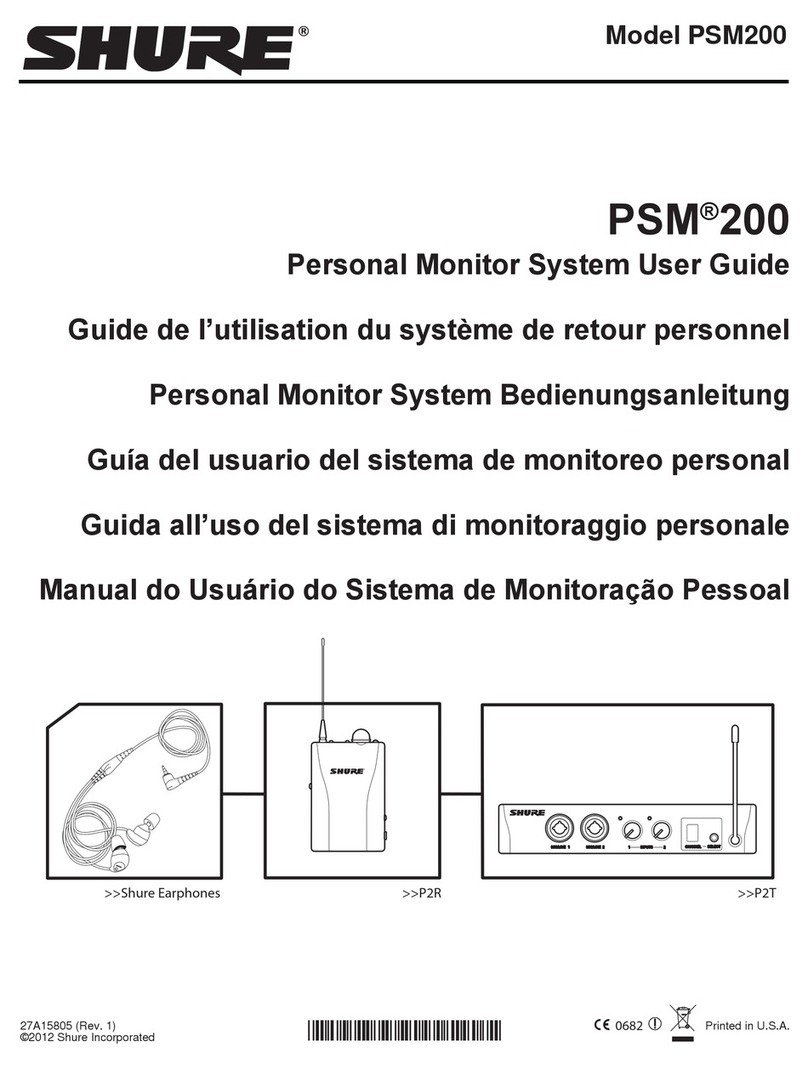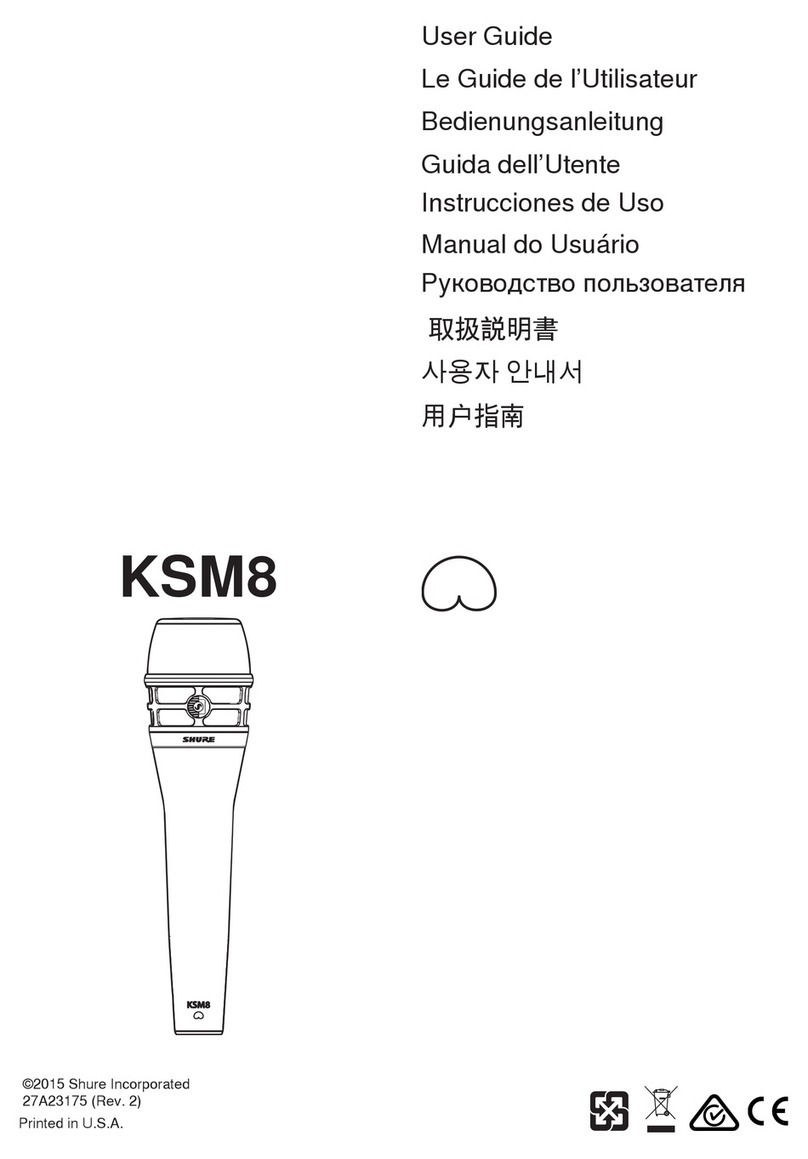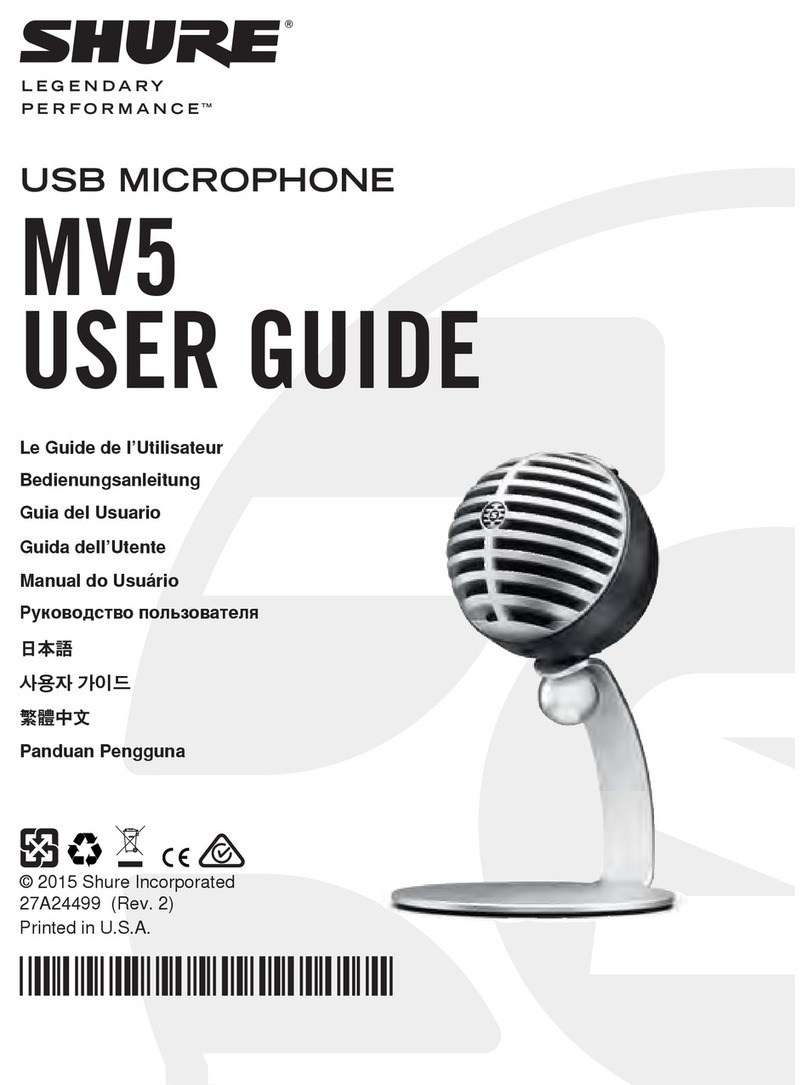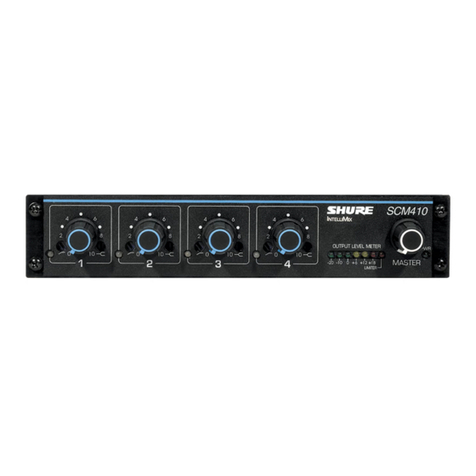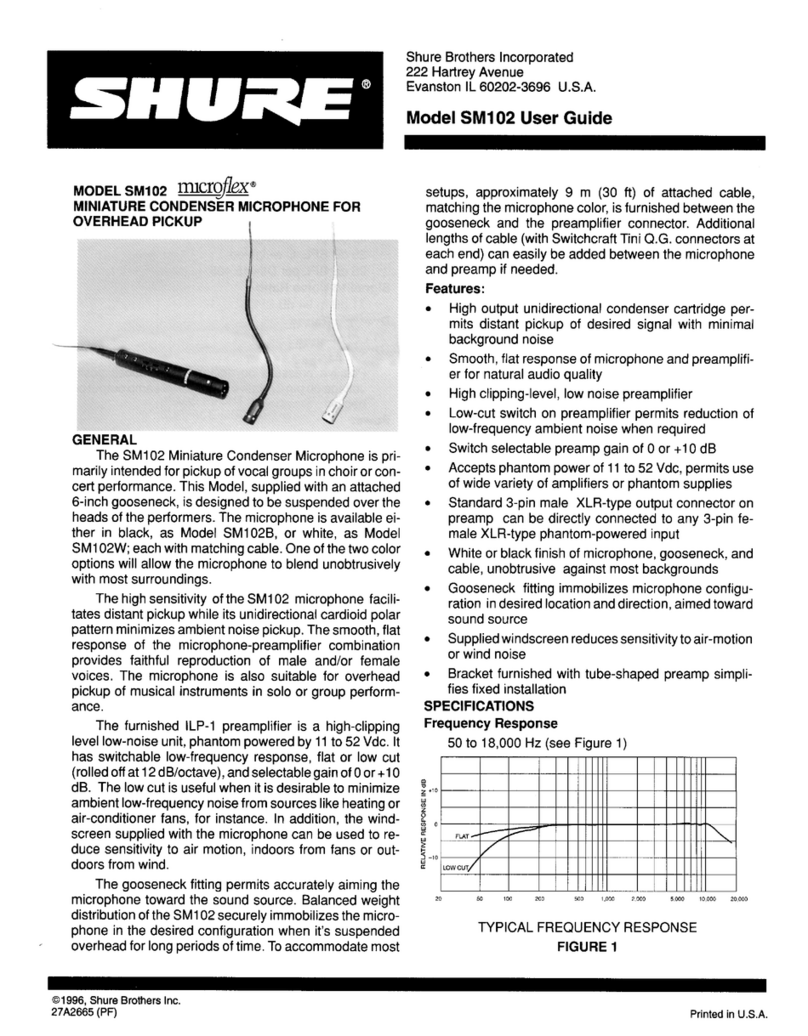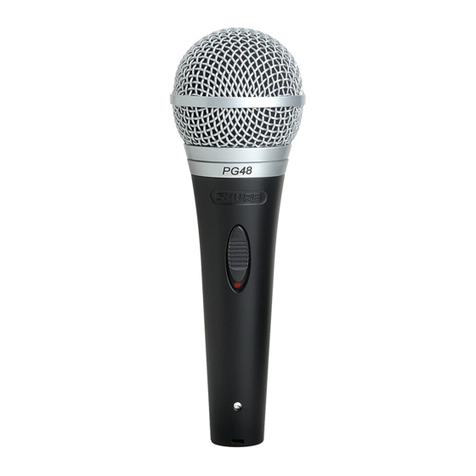
9
GUIDA D’USO DEL MICROFONO A COLLO D’OCA PER
PIANO ORIZZONTALE MICROFLEXMX412D
DESCRIZIONE GENERALE
I
m
odell
i S
hur
e M
icrofle
x s
eri
e M
X412
D s
on
o m
icrofon
i a c
ollo
d’oca
c
o
n c
ondensator
e t
ip
o m
iniatur
a a e
lettret
e d
otat
i di u
n
a b
a-
se per piano orizzontale e di un cavo di 3 m collegato. La base
permette
d
i u
tilizzar
e q
uest
i m
icrofon
i i
n s
al
e p
e
r a
pplicazion
i v
arie
in
c
u
i s
i r
ichiede
u
n’installazion
e r
apid
a o l
addov
e n
o
n s
i
a s
empli-
ce effettuare un’installazione permanente.
CARATTERISTICHE
•Ampia gamma dinamica e risposta in frequenza a larga
banda,
ai fini di una riproduzione precisa del suono in tutto
lo spettro audio.
•Capsule
intercambiabili, che permettono di scegliere il dia
-
gramma polare ottimale per ogni applicazione.
•Uscita bilanciata, senza trasformatore, per ottenere una
maggiore immunità dal rumore in lunghi tratti di cavo.
•Interruttore
acceso/spento (On/Of
f) programmabile e spia
LED di On/Off.
•Terminali
logici di ingresso
e uscita per il controllo a distan
-
za o per l’uso con mixer microfonici automatici.
•Antivento
i
n s
chiuma
p
oliuretanica
, c
o
n m
ontaggi
o a s
catto.
DESCRIZIONE DEI MODELLI
Tutti i microfoni Microflex sono disponibili con una qualsiasi
delle
tre capsule intercambiabili.
Il diagramma polare della cap
-
sula è indicato dal suffisso del numero di modello.
C = Cardioide, S = Supercardioide, O= Omnidirezionale
•MX412D/C:
microfono a collo d’oca, a minicondensatore,
per piani orizzontali, a cardioide, da 304,8 mm.
•MX412D/S: microfono a collo d’oca, a minicondensatore,
per piani orizzontali, a supercardioide, da 304, 8 mm.
•MX412D/O:
microfono a collo
d’oca, a minicondensatore,
per piani orizzontali, omnidirezionale, da 304,8 mm.
SCELTA DI UN DIAGRAMMA POLARE
Cardioide
(C).
Raccomandato per impianti generali di ampli
-
ficazione sonora. Angolo di ricezione (–3 dB) = 130.
Supercardioide (S). Raccomandato per impianti di amplifi-
cazione sonora che richiedono direttività o portata maggiori.
Angolo di ricezione (–3 dB) = 115.
Omnidirezionale
(
O).
R
accomandat
o p
e
r a
pplicazion
i d
i
m
oni-
toraggio
a d
istanz
a o d
i r
egistrazione
. A
ngol
o d
i r
icezion
e = 3
60.
DIRETTIVE GENERALI PER L’INSTALLAZIONE
1. Rivolgere
il microfono verso la sorgente sonora desidera
-
ta, quale l’oratore, e in direzione opposta a qualsiasi sor-
gente sonora indesiderata, come un diffusore.
2. La capsula del microfono deve trovarsi ad una distanza
compresa
tra 15 e 30 cm (6–12 pollici) dalla sorgente
sono
-
ra desiderata.
3. Usare
s
empr
e l
’antivent
o i
n d
otazion
e o
q
uell
o m
etallic
o (
op-
tional)
p
e
r t
ener
e s
ott
o c
ontroll
o i
l r
umor
e d
ell
a r
espirazione.
4. Se
quattro o più microfoni saranno in funzione contempo
-
raneamente, si raccomanda l’uso di un mixer automatico,
quali
i modelli SCM810 o FP410 della Shure, per ridurre al
minimo i problemi di feedback e rumore.
INSTALLAZIONE DEL MICROFONO
Fissaggio di un microfono ad una superficie di montaggio
(Figura 1)
1. Inserire
n
ell
a s
uperfici
e d
i m
ontaggi
o d
u
e v
it
i p
e
r l
egn
o N
.
6, distanziandole di 50,8 mm l’una dall’altra.
2. Posizionare i fori di montaggio sopra le teste delle viti e
spingere il microfono in posizione. Regolare adeguata-
mente l’altezza delle viti per fissare il microfono.
INSTALLAZIONE DELL’ANTIVENTO IN SCHIUMA POLIU-
RETANICA (FIGURA 2)
1. Premere l’antivento sul microfono finché non scatta nella
scanalatura situata sotto la capsula.
2. Per
rimuovere
l’antivento, allargare l’apertura nell’anello di
montaggio con un cacciavite o con l’unghia del pollice e
staccare con cautela l’antivento stesso.
FUNZIONI DEGLI INTERRUTTORI DIP INTERNI
Tutti i modelli MX412D sono dotati di interruttori DIP interni
che permettono di programmare l’interruttore acceso/spento
(On/Off) per una vasta gamma di applicazioni. Per accedere
agli interruttori DIP, rimuovere la placca inferiore.
DESCRIZIONE DEI TERMINALI LOGICI
Terminale di massa logica LOGIC GND: va collegato alla
massa logica di un mixer automatico, un commutatore o altro
apparecchio.
Può essere modificato per evitare anelli di massa.
Vedi sezione ”Modifiche delle funzioni logiche del modello
MX412D”.
Terminale
di
commutazione chiusura SWITCH OUT
: genera
un
segnale logico TTL a stato basso (0 V c.c.) quando si preme
l’interruttore
a membrana, altrimenti genera un segnale logico
TTL
a stato alto (5 V c.c.). Questo segnale è sempre disponibi
-
le,
per tutte le impostazioni dell’interruttore. La funzione di com
-
mutazione
chiusura
fornisce una chiusura momentanea quan
-
do S1 è Off ed una chiusura a ritenuta quando S1 è On.
MODIFICHE DELLE FUNZIONI LOGICHE DEL MODELLO
MX412D
Isolamento della massa logica dalla massa audio
1. Rimuovere il ponticello R40 dalla parte superiore della
scheda di circuiti.
2. Accertarsi che il terminale LOGIC GND sia collegato alla
massa
logica di un mixer automatico, un
commutatore o al
-
tro apparecchio.
Impostazione
del terminale SWITCH OUT su chiusura mo
-
mentanea permanente
Per
adattare
il microfono ad apparecchi collegati che richie
-
dono una chiusura momentanea del microfono stesso (anche
quando la funzione desiderata del microfono corrisponde ad
una
attivazione/disattivazione della chiusura
a ritenuta), proce
-
dere come segue.
1. Rimuovere R45 dalla parte superiore della scheda di circuiti.
2. Reinstallare
R45 nella posizione R46 nella parte superiore
della scheda di circuiti.
Modifiche personalizzate dell’interruttore S4
S4
può essere modificato per creare funzioni logiche perso
-
nalizzate.
Quando S4 è in posizione On, la piazzola W4 è colle
-
gata a quella W5.

